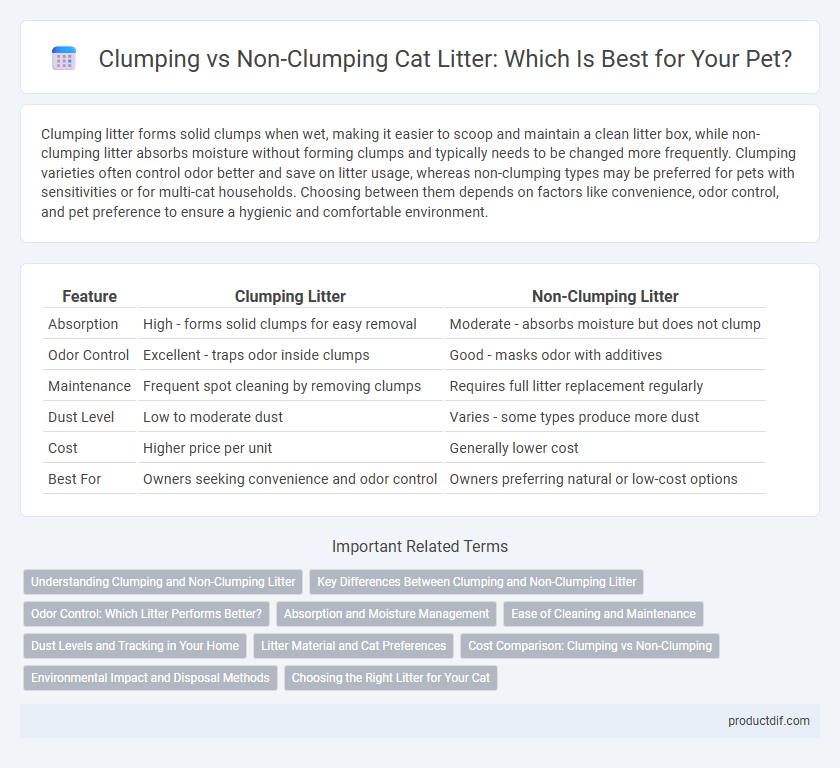Clumping litter forms solid clumps when wet, making it easier to scoop and maintain a clean litter box, while non-clumping litter absorbs moisture without forming clumps and typically needs to be changed more frequently. Clumping varieties often control odor better and save on litter usage, whereas non-clumping types may be preferred for pets with sensitivities or for multi-cat households. Choosing between them depends on factors like convenience, odor control, and pet preference to ensure a hygienic and comfortable environment.
Table of Comparison
| Feature | Clumping Litter | Non-Clumping Litter |
|---|---|---|
| Absorption | High - forms solid clumps for easy removal | Moderate - absorbs moisture but does not clump |
| Odor Control | Excellent - traps odor inside clumps | Good - masks odor with additives |
| Maintenance | Frequent spot cleaning by removing clumps | Requires full litter replacement regularly |
| Dust Level | Low to moderate dust | Varies - some types produce more dust |
| Cost | Higher price per unit | Generally lower cost |
| Best For | Owners seeking convenience and odor control | Owners preferring natural or low-cost options |
Understanding Clumping and Non-Clumping Litter
Clumping litter is made from bentonite clay that absorbs moisture and forms solid clumps, making it easier to scoop and manage odor effectively. Non-clumping litter, often composed of materials like clay, silica, or recycled paper, absorbs moisture without forming clumps, requiring more frequent complete changes to maintain freshness. Understanding the difference in absorption and maintenance helps pet owners choose the right litter based on convenience, odor control, and cost-efficiency.
Key Differences Between Clumping and Non-Clumping Litter
Clumping litter forms solid masses when it absorbs moisture, making it easier to scoop and control odors, while non-clumping litter absorbs moisture without forming clumps, relying on its capacity to absorb and neutralize liquids evenly. Clumping litter typically contains bentonite clay for quick clumping action, whereas non-clumping litter often uses materials like clay granules, silica, or recycled paper for absorption. The choice between clumping and non-clumping litter affects maintenance frequency, odor control, and dust production in a cat's living environment.
Odor Control: Which Litter Performs Better?
Clumping litter typically offers superior odor control due to its ability to form tight clumps that trap moisture and waste, preventing the release of unpleasant smells. Non-clumping litter absorbs moisture without forming clumps, which may allow odors to linger longer and require more frequent changing. Pet owners seeking effective odor management often prefer clumping litter for its convenience and enhanced odor-locking capabilities.
Absorption and Moisture Management
Clumping litter features bentonite clay that forms solid clumps upon absorbing moisture, enabling easy removal and superior odor control. Non-clumping litter typically absorbs moisture without forming clumps, offering longer-lasting use but less efficient moisture encapsulation. Effective moisture management in clumping litter reduces bacterial growth and keeps the litter box dryer compared to non-clumping varieties.
Ease of Cleaning and Maintenance
Clumping litter forms solid clumps upon contact with moisture, making it easier to scoop and remove waste quickly, which helps maintain a clean litter box environment. Non-clumping litter absorbs moisture but does not form clumps, requiring full litter changes more frequently to avoid odors and mess. Pet owners prioritizing ease of cleaning often prefer clumping litter for its convenience and time-saving maintenance.
Dust Levels and Tracking in Your Home
Clumping litter typically produces less dust than non-clumping varieties, reducing airborne particles that can affect both pets and owners. Non-clumping litter tends to track more outside the litter box, spreading granules across floors and furniture. Choosing low-dust, tracking-resistant formulas helps maintain cleaner air quality and minimizes mess in your home environment.
Litter Material and Cat Preferences
Clumping litter is typically made from bentonite clay, which absorbs moisture and forms solid clumps for easy scooping, while non-clumping litter often consists of clay, silica, or natural materials like pine or paper, offering varied textures and odor control. Cats generally prefer clumping litter for its clean and dry feel, but some may favor non-clumping types due to softer textures or reduced dust. Understanding feline preferences and litter materials can help pet owners choose the best option to maintain hygiene and comfort in the litter box.
Cost Comparison: Clumping vs Non-Clumping
Clumping litter typically costs more upfront than non-clumping litter due to its specialized formula that forms solid clumps for easier cleaning. Over time, clumping litter can be more cost-effective since it requires less frequent full replacement, reducing overall litter consumption. Non-clumping litter often has a lower initial price but demands more frequent changes, increasing long-term expenses and waste.
Environmental Impact and Disposal Methods
Clumping litter, often made from bentonite clay, poses environmental challenges due to its non-biodegradable nature and contributes significantly to landfill waste. Non-clumping litter made from biodegradable materials such as recycled paper, corn, or wheat offers a more eco-friendly alternative, breaking down naturally and reducing environmental footprint. Disposal methods for clumping litter typically require landfill use, whereas biodegradable litter allows for composting or environmentally safer disposal options.
Choosing the Right Litter for Your Cat
Clumping litter offers easy scooping and odor control by forming solid clumps when wet, making maintenance simpler for busy cat owners. Non-clumping litter tends to absorb moisture throughout rather than clumping, often preferred for cats with sensitive paws or respiratory issues due to its typically lower dust content. Selecting the right litter depends on your cat's preferences, health needs, and your cleaning routine to ensure both comfort and hygiene.
Clumping Litter vs Non-Clumping Litter Infographic

 productdif.com
productdif.com